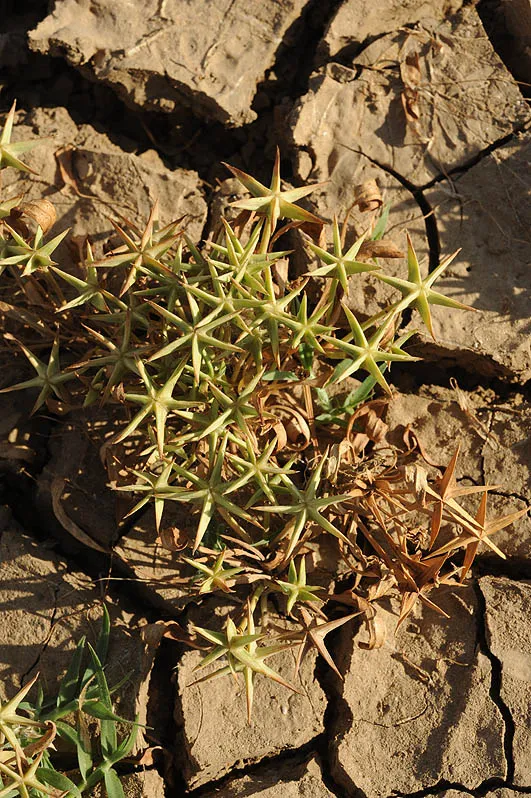False Sycomore Fig
Ficus palmata


Ficus pseudosycomorus fruits are eaten
by birds, bats and humans. The milky sap is used in folk medicine for treating external
wounds, warts, and eye infections and as a cure for constipation. The taste of
the fruit is spicy and has a "prickly" sweet aftertaste for several
minutes unlike the familiar sweetness of the cultured fig fruit.
A single isolated Ficus
pseudosycomorus tree grows on one site in Israel, in
the Elat Mountains. Moti Shem Tov and Dudi Rivner found it last year in Wadi
Etek. Another tree was found in the Elat Mountains at Tmilet Radedi on the
Israeli Egyptian border from the 1940s to 1980. This tree probably dried up and
died in the early 1980s. The fig trees in En Orhot and En Hava in central Negev
were once believed to be old F.
pseudosycomorus trees, but it turned out that they were only fig trees.
The tree from the Vardit canyon is probably a fig tree as well.
Ficus pseudosycomorus is common on the
Southern Sinai peaks and the Edom Mountains, where it grows in rocky crevices and
cliffs and along shaded wadis and canyons beds.
The genus Ficus consists of about 750 species found
mainly in the tropics in all the continents, with the richest diversity
concentrated in the Indo-Malaysian Archipelago and northern Australia. The genus
include trees, shrubs and vines, mostly with thick evergreen leaves. Ficus
species have a unique inflorescence gathered in a closed sphere termed a “syconium”
that is pollinated by tiny wasps. Each species of Ficus has its own
special pollinator.
Although Ficus is a tropical genus, most of its
species are evergreen. However,
F. pseudosycomorus
and F.carica, belong to a special Ficus group that underwent a secondary speciation
in the geological past, in the arid mountains of western Asia that are cold in
the winter. The species became winter deciduous as an adaptation to these
conditions.
A single specimen of Ficus pseudosycomorus
grows on a single site in the Elat Mountains and has become
extinct from another site, probably because of changes in subterranean flow
regimes following the construction and paving of the border road in the 1980s.
The fact that only a single isolated tree grows in Israel exposes the species
to a real danger of extinction, particularly given the absence of specimens or
populations in other places. Although the number of specimens in a population
or at a site was not weighted in the calculation of the species' red number as presented
in this book, it has to be taken into account in the characterization of the
threat facing the species. F.
pseudosycomorus is an example of this. The species is protected by law
in Israel.
Genetic testing should
be conducted on the few solitary Ficus trees in the springs and canyons
of the central Negev to see if these are specimens of Ficus pseudosycomorus or of F.carica. The species should be reintroduced and acclimatized
from rooted cuttings in one of the Eilat Mountains canyons at, e.g. Wadi Netafim
or Wadi Shlomo.
Ficus pseudosycomorus is a tree or shrub
that grows mainly in the high mountains of Afghanistan and Iran. During the
last glacial age or in the Pliocene it apparently spread together with
Irano-Turanian vegetation towards Edom, Sinai and up to Jebel Glila in Egypt, its
western distribution limit. F. pseudosycomorus is
a wild species, but is very close taxonomically to the fig tree, thus we can
assume that it was the source for the cultured fig tree.
F. pseudosycomorus is relatively common
in the Edom canyons, Southern Jordan in the area of Wadi Ramm and the Aqaba Mountains.
In the Petra region and northern Edom, most of the specimens are hybrids of F.carica and F. pseudosycomorus. The
characters of the cultured species become stronger the farther north we go. It is relatively common in
Southern Sinai and there, as in the Elat region, there are almost no hybrids
with F.carica.
Ficus
pseudosycomorus is a tree-shrub very similar to F.
carica (fig tree), quite common in Southern Sinai and southern
Jordan, which once grew in Israel in Tmilet Radedi in the Elat Mountains and
was recently found again in the Elat Mountains in Wadi Etek. A population should be
established in one of the Elat Mountains' canyons.
גליל, י. 1982, הסוג פיקוס. החי והצומח של ישראל, אנציקלופדיה שימושית מאוירת. צמחים בעלי פרחים, עמ' 34-331. הוצאת החברה להגנת הטבע ומשרד הביטחון.
Current Occupancy Map
| 1000 squre meter pixel | 5000 squre meter pixel | 10000 squre meter pixel | |
|---|---|---|---|
| number of observations | 0 | 0 | 0 |
| in total pixels | 0 | 0 | 0 |
| Family | Moraceae |
| Classification | On the endangered species list |
| Ecosystem | Desert |
| Chorotype | Sudanian – Irano-Turanian |
| Conservation Site | Wadi Etek in the Elat Mountains Nature Reserve |
| Rarity |
1
6
6
|
|---|---|
| Vulnerability |
0
2
4
|
| Attractiveness |
0
0
4
|
| Endemism |
0
0
4
|
| Red number |
1
4.2
10
|
| Peripherality | 0 |
| IUCN category | DD EW EX LC CR EN VU NT |
| Threat Definition according to the red book | Endangered |
 Based on:
Based on:






